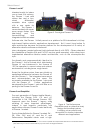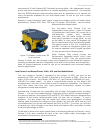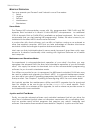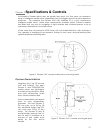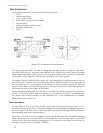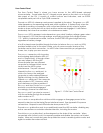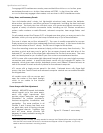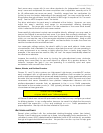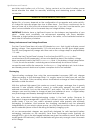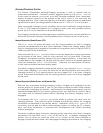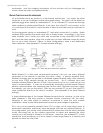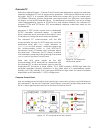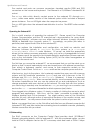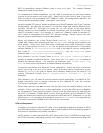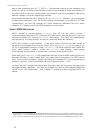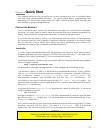
Specifications and Controls
and slide each battery out of its bay. Spring contacts on the robot’s battery power
board alleviate the need for manually attaching and detaching power cables or
connectors.
Balance the batteries in your robot.
Battery life, of course, depends on the configuration of accessories and motor activity.
AT charge life typically ranges from two to three hours. The DX runs continuously for six
hours or more; up to four hours with onboard computer. If you don’t use the motors, your
robot’s microcontroller will run for several days on a single battery charge.
IMPORTANT: Batteries have a significant impact on the balance and operation of your
robot. Under most conditions, we recommend operating with three batteries.
Otherwise, a single battery should be mounted in the center, or two batteries inserted on
each side of the battery container.
Battery Indicators and Low Voltage Conditions
The User Control Panel has a bi-color LED labeled BATTERY that visually indicates current
battery voltage. From approximately 12.5 volts and above, the LED glows bright green.
The LED turns progressively orange and then red as the voltage drops to approximately
11.5 volts.
Aurally, the User Control Panel’s buzzer, if active (see the AROS SoundTog client
command and FLASH parameter), will sound a repetitive alarm if the battery voltage
drops consistently below the FLASH LowBattery level. If the battery voltage drops below
11 volts, the microcontroller’s watchdog server automatically shuts down a client
connection and notifies the computer, via the HOST RI (ring indicator) pin, to shut down
and thereby prevent data loss or systems corruption due to low batteries.
Recharging
Typical battery recharge time using the recommended accessory (800 mA) charger
varies according to the discharge state; it is roughly equal to three hours per volt per
battery. The Power Cube accessory allows simultaneous recharge of three swappable
batteries outside the robot.
With the optional high-speed (4A maximum current) charger, recharge time is greatly
reduced. It also supplies sufficient current to continuously operate the robot and
onboard accessories, such as the onboard PC and radios. But with the higher-current
charger, care must be taken to charge at least two batteries at once. A single battery
may overcharge and thereby damage both itself and the robot.
The new automated docking/recharging system is the best option. Because its
integrated charge-management system has sufficient power and actively adjusts to
system loads, it can run your robot's onboard systems while properly and optimally
recharging its batteries. And because the charging mechanism may be operated
independently of your robot's systems power, you may start up and shut down your robot
and its onboard systems without disturbing the battery charging cycle.
All our recommended chargers are specifically designed for safe lead-acid battery
recharging. Indicators on the module’s face show fast-charge mode (typically an
orange LED) in which the discharged batteries are given the maximal current, and trickle
mode (green LED indicator), which the batteries are given only enough current to remain
at full charge.
16



